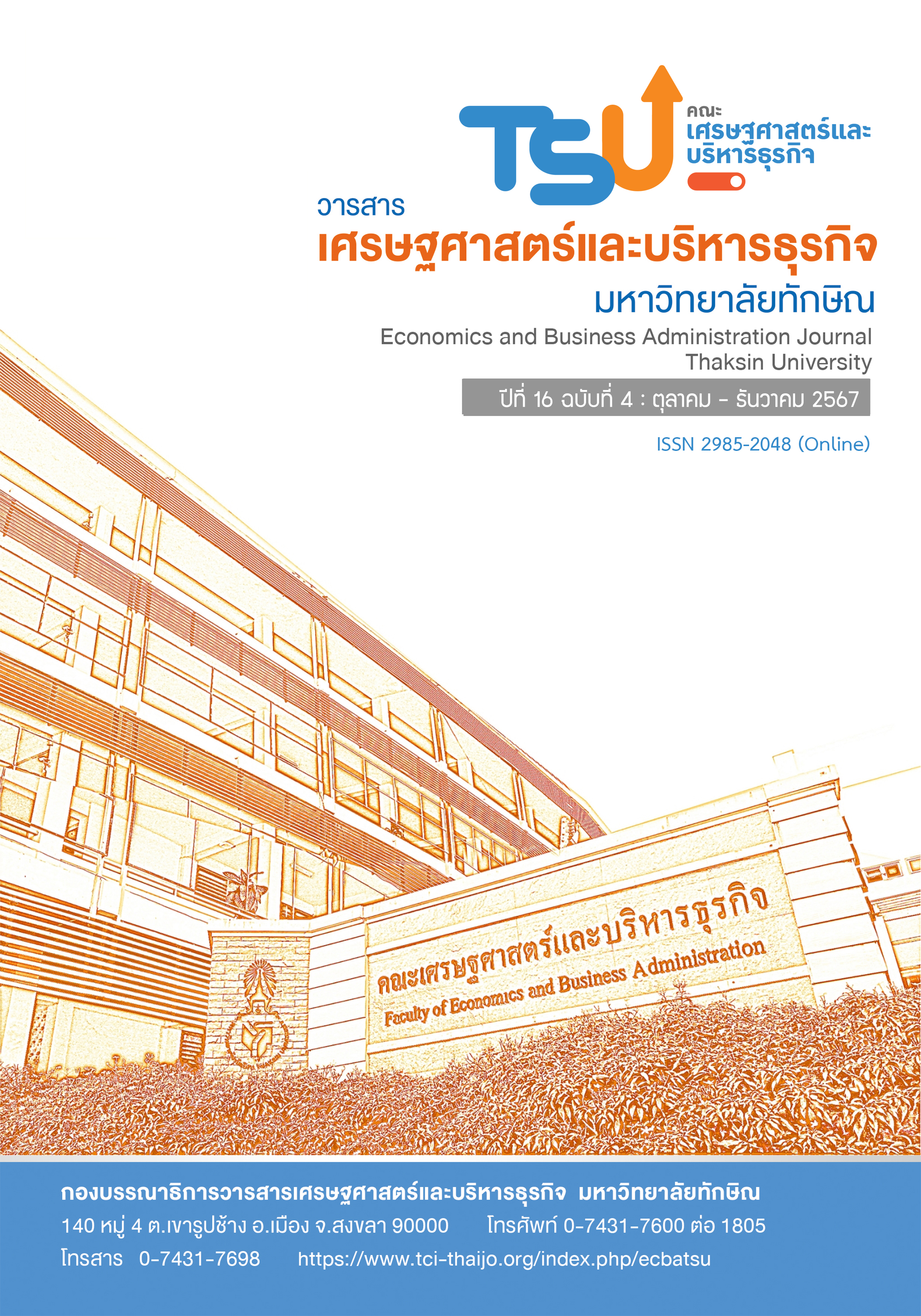Forecasting Tourism Trends in Eastern Economic Corridor (EEC) with Google Trends
DOI:
https://doi.org/10.55164/ecbajournal.v16i4.267214Keywords:
Google Trends, Tourism, Mixed frequency, EEC, ForecastingAbstract
This study aims to investigate the potential of Google Trends variables in predicting short-term tourism trends and to assess the impact of the Coronavirus Disease 2019 (COVID-19) situation on the tourism industry in the Eastern Economic Corridor (EEC), which is a key source of household income. The data used in this research includes the number of tourists (monthly frequency) and Google Trends data related to tourism (weekly frequency), covering the period from January 2015 to June 2021. The study employs an Autoregressive model and the ADL-MIDAS model, followed by an out-of-sample forecast. The results indicate that Google Trends variables enhance the ability to explain changes in visitor counts with a positive correlation. Moreover, the forecast accuracy is improved by including Google Trends variables in the Autoregressive model. The ADL-MIDAS model, on the other hand, is more effective for forecasting under unique circumstances, such as during economic recessions or disease outbreaks. In addition, the study of the consequences of Coronavirus Disease 2019 is shown to reduce travel-related searches, visitor numbers, and tourism revenue. Policymakers can utilize Google Trends data to better anticipate and respond to such disruptions.
References
Andreou, E., Ghysels, E., & Kourtellos, A. (2013). Should Macroeconomic Forecasters Use Daily Financial Data and How? Journal of Business & Economic Statistics, 31(2), 240-251.
Askitas, N., & Zimmermann, K. F. (2009). Google Econometrics and Unemployment Forecasting. Applied Economics Quarterly, 55(2), 107-120.
Chinsiraprapha, A. (2021). The Impact of COVID-19 on the Tourism Economy in the Eastern Region. Journal of Industrial Business Administration, 3(2), 1–4. Retrieved from https://so03.tci-thaijo.org/index.php/iba/article/view/257511
Choi, H., & Varian, H. (2009). Predicting Initial Claims for Unemployment Benefits. Google Inc, 1, 1-5.
Engle, R. F., Ghysels, E., & Sohn, B. (2013). Stock Market Volatility and Macroeconomic Fundamentals. Review of Economics and Statistics, 95(3), 776-797.
Ettredge, M., Gerdes, J., & Karuga, G. (2005). Using Web-based Search Data to Predict Macroeconomic Statistics. Communications of the ACM, 48(11), 87-92.
Ghysels, E., Santa-Clara, P., & Valkanov, R. (2004). The MIDAS Touch: Mixed Data Sampling Regression Models. UCLA: Finance. Retrieved from https://escholarship.org/uc/item/9mf223rs
Gulati, V. (2023). EEC Economy in 2022 and Outlook in 2023. Retrieved February 1, 2023, from https://www.scbeic.com/th/detail/product/8749
Havranek, T., & Zeynalov, A. (2021). Forecasting Tourist Arrivals: Google Trends Meets Mixed-frequency Data. Tourism Economics, 27(1), 129-148.
Hopken, W., Eberle, T., Fuchs, M., & Lexhagen, M. (2019). Google Trends Data for Analysing Tourists’ online Search Behaviour and Improving Demand Forecasting: the Case of Åre, Sweden. Information Technology & Tourism, 21, 45-62.
Jiranyakul, K. (2019). The Validity of the Tourism-Led Growth Hypothesis for Thailand. Available at SSRN 2816239.
Kapetanios, G., & Papailias, F. (2018). Big Data & Macroeconomic Nowcasting: Methodological Review. Economic Statistics Centre of Excellence (ESCoE) Discussion Papers ESCoE DP-2018-12, Economic Statistics Centre of Excellence (ESCoE).
Keerativibool, W. (2013). Forecasting Model for the Number of International Tourist Arrivals to Thailand. Srinakharinwirot Science Journal. 29(2), 9-26.
Kingnetr, N., Tungtrakul, T., & Sriboonchitta, S. (2017). Forecasting GDP Growth in Thailand with Different Leading Indicators Using MIDAS Regression Models. Robustness in Econometrics, 692, 511-521. DOI: https://doi.org/10.1007/978-3-319-50742-2_31
Kingnetr, N., Tungtrakul, T., & Sriboonchitta, S. (2018). Does Forecasting Benefit from Mixed-frequency Data Sampling Model: The Evidence from Forecasting GDP Growth Using Financial Factor in Thailand. International Conference of the Thailand Econometrics Society, 753, 430-442. DOI: https://doi.org/10.1007/978-3-319-70942-0_31
Kuzin, V., Marcellino, M., & Schumacher, C. (2011). MIDAS vs. Mixed-frequency VAR: Nowcasting GDP in the Euro Area. International Journal of Forecasting, 27(2), 529-542.
Nakavachara, V., & Lekfuangfu, N. W. (2018). Predicting the Present Revisited: The Case of Thailand. Thailand and The World Economy, 36(3), 23-46.
Onder, I. (2017). Forecasting Tourism Demand with Google Trends: Accuracy Comparison of Countries vs. Cities. International Journal of Tourism Research, 19(6), 648-660.
Prajongkarn, W., Reancharoen, T., & Surawattananon N. (2020). How to Switch on the Tourism Sector to be Worth the Risk. Retrieved January 29, 2021, from https://www.bot.or.th/Thai/ResearchAndPublications/articles/Pages/Article_13Oct2020.aspx.
Rangsipol, K. (2021). EEC Economy in a New Wave of COVID-19 Outbreak. Retrieved February 1, 2023, from https://www.scbeic.com/th/detail/product/7321
Rungjindarat , N., & Phansaita, N. (2018). Forecasting Russian Tourist Arrivals to Thailand Using SARIMA Model. Dusit Thani College Journal, 10(1), 180-191.
Sangkhamaneenakon, O. (2018). Can Google Trends Help to Predict Financial Market (SET50). Thammasat University.
Stephens-Davidowitz, S., & Varian, H. (2014). A Hands-on Guide to Google Data. Technical report, Google.
Untong, A. (2014). Examining the Tourism-led Growth Hypothesis: A Case Study of Thailand. Applied Economics Journal, 21(2), 30-51.
Wichitaksorn, N. (2020). Analyzing and Forecasting Thai Macroeconomic Data Using Mixed-Frequency Approach (Discussion Paper No. 146). Puey Ungphakorn Institute for Economic Research. https://www.pier.or.th/dp/146/
Downloads
Published
How to Cite
Issue
Section
License
Copyright (c) 2024 Faculty of Economics and Business Administration, Thaksin University

This work is licensed under a Creative Commons Attribution-NonCommercial-NoDerivatives 4.0 International License.




